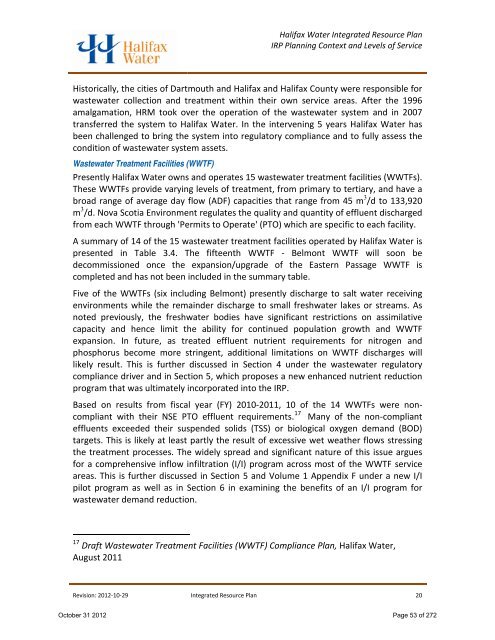volume 1 - Halifax Regional Municipality
volume 1 - Halifax Regional Municipality
volume 1 - Halifax Regional Municipality
Create successful ePaper yourself
Turn your PDF publications into a flip-book with our unique Google optimized e-Paper software.
<strong>Halifax</strong> Water Integrated Resource Plan<br />
IRP Planning Context and Levels of Service<br />
Historically, the cities of Dartmouth and <strong>Halifax</strong> and <strong>Halifax</strong> County were responsible for<br />
wastewater collection and treatment within their own service areas. After the 1996<br />
amalgamation, HRM took over the operation of the wastewater system and in 2007<br />
transferred the system to <strong>Halifax</strong> Water. In the intervening 5 years <strong>Halifax</strong> Water has<br />
been challenged to bring the system into regulatory compliance and to fully assess the<br />
condition of wastewater system assets.<br />
Wastewater Treatment Facilities (WWTF)<br />
Presently <strong>Halifax</strong> Water owns and operates 15 wastewater treatment facilities (WWTFs).<br />
These WWTFs provide varying levels of treatment, from primary to tertiary, and have a<br />
broad range of average day flow (ADF) capacities that range from 45 m 3 /d to 133,920<br />
m 3 /d. Nova Scotia Environment regulates the quality and quantity of effluent discharged<br />
from each WWTF through 'Permits to Operate' (PTO) which are specific to each facility.<br />
A summary of 14 of the 15 wastewater treatment facilities operated by <strong>Halifax</strong> Water is<br />
presented in Table 3.4. The fifteenth WWTF - Belmont WWTF will soon be<br />
decommissioned once the expansion/upgrade of the Eastern Passage WWTF is<br />
completed and has not been included in the summary table.<br />
Five of the WWTFs (six including Belmont) presently discharge to salt water receiving<br />
environments while the remainder discharge to small freshwater lakes or streams. As<br />
noted previously, the freshwater bodies have significant restrictions on assimilative<br />
capacity and hence limit the ability for continued population growth and WWTF<br />
expansion. In future, as treated effluent nutrient requirements for nitrogen and<br />
phosphorus become more stringent, additional limitations on WWTF discharges will<br />
likely result. This is further discussed in Section 4 under the wastewater regulatory<br />
compliance driver and in Section 5, which proposes a new enhanced nutrient reduction<br />
program that was ultimately incorporated into the IRP.<br />
Based on results from fiscal year (FY) 2010-2011, 10 of the 14 WWTFs were noncompliant<br />
with their NSE PTO effluent requirements. 17 Many of the non-compliant<br />
effluents exceeded their suspended solids (TSS) or biological oxygen demand (BOD)<br />
targets. This is likely at least partly the result of excessive wet weather flows stressing<br />
the treatment processes. The widely spread and significant nature of this issue argues<br />
for a comprehensive inflow infiltration (I/I) program across most of the WWTF service<br />
areas. This is further discussed in Section 5 and Volume 1 Appendix F under a new I/I<br />
pilot program as well as in Section 6 in examining the benefits of an I/I program for<br />
wastewater demand reduction.<br />
17 Draft Wastewater Treatment Facilities (WWTF) Compliance Plan, <strong>Halifax</strong> Water,<br />
August 2011<br />
Revision: 2012-10-29 Integrated Resource Plan 20<br />
October 31 2012 Page 53 of 272
















